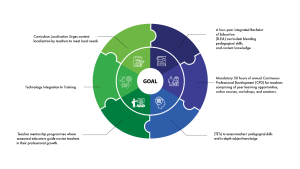Understanding India’s Challenges with Poor Student Learning Outcomes
Since the first National Policy on Education (NPE) in 1968, India has introduced several ambitious and progressive education policies. These policies firmly support radical reorganisation, equitable educational opportunities, and the universalisation of education.
Despite these efforts, learning levels remain dismal, and student learning outcomes are significantly underachieved. Overall, student achievement is poor and inconsistent across the country.
These are not random claims but based on data presented by multiple credible survey. According to Pratham’s 2018 report, nearly half of Grade V students in rural areas could not read a Grade II-level text, and only one-third could perform simple division.
The National Achievement Survey (NAS), conducted in November 2021 and covering over 3.4 million students, highlighted a nationwide decline in student learning levels across all grades and subjects. Similarly, the Performance Grading Index (PGI) 2.0 revealed that all 28 states and eight Union Territories scored below 50% on learning outcomes and quality. This data indicates the country’s alarming educational outcomes and student achievement, implying that the educational system is not synchronised with the planned student learning outcomes.
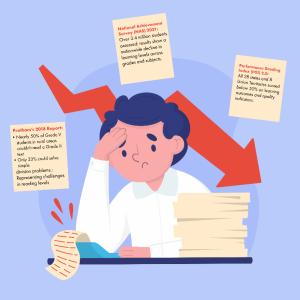
This learning outcomes crisis compels us to ponder: Why have decades of competitive educational policies and reforms failed to achieve their intended learning goals? What systemic barriers have hindered academic progress, leading to persistently low student learning outcomes? Let’s examine.
Reasons for Poor Student Learning Outcomes in India
A closer look at the underlying reasons for low student learning outcomes in India reveals various social, economic, and administrative challenges that hinder educational outcomes across the country.
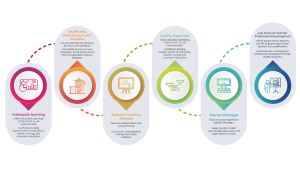
Critical Reasons for Low Student Learning Outcomes
Inadequate spending: India’s education spending languishes at 2.61% of GDP, much lower than the recommended 6% by the Education 2030 Framework for Action. Insufficient spending doesn’t adequately support the existing and new educational structures and initiatives, like school infrastructure, school improvement, teacher education and training, adversely impacting classroom instruction and student achievement.
Insufficient infrastructure and facilities: A significant number of schools do not have essential facilities such as spacious, well-lit classrooms, furniture, libraries, playgrounds and sanitation. Several schools still need a building, and many operate in dilapidated and under-construction buildings. The need for a safe, stimulating infrastructure makes it hard for students to engage with their studies. Studies may be affected due to health risks due to poor sanitation, unclean surroundings, and the absence of play areas. Furthermore, inadequate transportation infrastructure forces many to drop out of their schools.
According to the Unified District Information System for Education (UDISE+) data for the 2021-22 academic year, critical gaps exist in digital infrastructure, with only 44.6% of schools having computer facilities and 33.9% equipped with internet connectivity, restricts students’ exposure to information and limits the integration of modern teaching strategies.
Outdated teaching methods: Most Indian schools follow age-old instructional strategies focusing on memorisation instead of nurturing high-order learning skills based on critical and creative thinking skills. Alienating innovative and scientific teaching-learning processes makes it difficult for students to apply concepts to achieve higher learning outcomes. Additionally, students often learn outdated information because the curriculum isn’t updated regularly, further impacting student achievement.
Quality Disparities: Educational quality varies significantly across regions, states, schools, and socioeconomic groups. Students in north-eastern states often perform below the national average in most subjects. Students from wealthier families have better learning experiences than those from economically disadvantaged backgrounds who frequently attend underfunded schools that lack essential facilities. This gap in resources can be particularly challenging for students who may also need to work to help support their families, which often leads to missed classes and lower academic performance. Moreover, private schools usually provide a superior leaning environment in terms of infrastructure and the quality of education compared to government schools. Such disparities in resources and classroom instruction results in uneven learning outcomes. Some students excel while other lag behind unable to realise their full potential.
Teacher shortages: Another significant contributor to low student learning outcomes is the shortage of qualified teachers in India, particularly in rural areas. UDISE+ 2021-22 reports that states with lower population densities, such as Arunachal Pradesh and Himachal Pradesh, have the ideal PTR, but states with higher population densities, such as Bihar, have too few instructors, resulting in overcrowded classrooms. Madhya Pradesh, Andhra Pradesh, and Rajasthan were among the states that reported single-teacher schools or teachers teaching multiple grades simultaneously. This situation severely restricts pupil’s individualised attention.
Low focus on teacher professional development – A 2023 study conducted by the Tata Institute of Social Sciences revealed that 16% of teachers in private schools and 4% of teachers in government schools lack professional qualifications. This situation gets grimmer with many schools not having robust policies for upskilling teachers through ongoing teacher coaching, in-service teacher training and professional development programmes. Unskilled and unqualified teachers often struggle to grasp pedagogical skills, adopt scientific assessment strategies, understand child psychology and implement government recommendations to improve educational outcomes.
The challenges to better student achievement requires immediate and decisive actions. Is India and the global community taking some significant steps to deal with these challenges and align education with shared, broader developmental goals? Let’s find out.
Sustainable Development Goals
Education quality is among the pervasive global challenges that impact the Earth and its people’s peace, prosperity and sustenance. As an urgent remedial action to address the root causes of these challenges, the United Nations Member States adopted a shared blueprint- The 2030 Agenda for Sustainable Development. Central to this agenda are 17 Sustainable Development Goals (SDGs). These 17 SDGs are interconnected goals we must realise by 2030 in a global partnership. The 17 SDGs are:
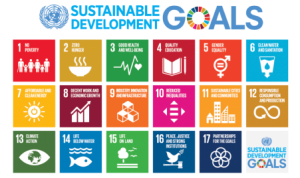
Sustainable Development Goals for Joint Global Action
SDG 4 on Quality Education: It aims to provide all individuals with access to quality education that is inclusive and equitable and caters to diverse populations, including marginalised and vulnerable groups.
Key Targets
SDG 4 comprises ten specific targets categorised into seven outcomes and three means of implementation targets.
The ‘outcome’ targets delineate the educational outcomes that SDG 4 seeks to achieve by 2030. The ‘means of implementation’ targets focus on the necessary actions to attain these educational outcomes. These targets are designed to track progress in achieving quality education globally.
The Outcome Targets
- Target 4.1- By 2030, guarantee that all girls and boys complete free, equitable, and high-quality primary and secondary education that results in meaningful and effective learning outcomes.
- Target 4.2: By 2030, make sure that all girls and boys can access quality early childhood development programs, care, and pre-primary education to prepare for primary school.
- Target 4.3: By 2030, guarantee that all women and men have equal opportunities to competitively priced quality vocational, technical and tertiary education, including university programmes.
- Target 4.4: By 2030, ensure a significant increase in the number of youth and adults with essential technical and vocational skills seeking work opportunities, respectable jobs, and entrepreneurship.
- Target 4.5: By 2030, eradicate gender inequalities in education and guarantee equal learning opportunities at all educational and vocational training levels for vulnerable groups, including individuals with disabilities, indigenous communities, and children in at-risk circumstances.
- Target 4.6: By 2030, guarantee that all young people and a significant number of adults, regardless of gender, attain literacy and numeracy skills.
- Target 4.7: By 2030, ascertain that all learners gain the knowledge and skills necessary to support sustainable development.
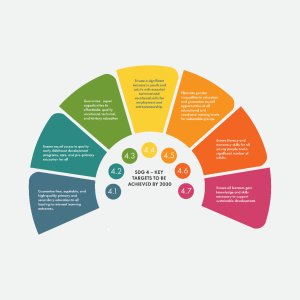
SDG4 Educational Outcomes Targets
Means of Implementation Target
- Target 4.a: Set up and improve educational facilities that are considerate of children, individuals with disabilities, and gender differences, ensuring they offer safe, non-violent, inclusive, and effective learning environments for everyone.
- Target 4.b: By 2030, significantly increase the availability of scholarships worldwide for individuals from developing nations, especially those from the least developed countries, small island developing states, and African nations. These scholarships should support enrolment in higher education programs, including vocational training and fields related to information and communications technology, technical studies, engineering, and science in developed and developing countries.
- Target 4.c: By 2030, significantly increase the number of qualified teachers worldwide, mainly through international collaboration for teacher training in developing nations, especially in the least developed countries and small island developing states.
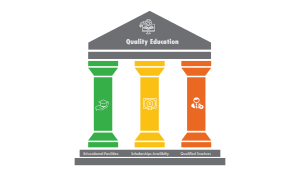
SDG4 Implementation Targets to Attain Educational Outcomes
Aligning educational systems with ambitious Sustainable Development Goals (SDGs) requires a strong emphasis on enhancing student learning outcomes, which skilled and qualified teachers significantly influence. There are scores of other reasons for teacher education, comprehensive teacher training and professional development programmes. Let’s examine them.
Need for Teacher Training Programmes in India
Global focus on quality education has rendered teacher training indispensable. Here’s why:
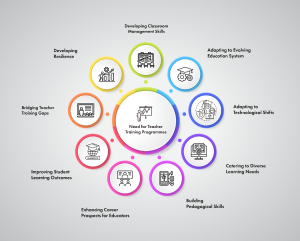
- Adapting to Evolving Education System: Advancements in technology, curriculum reforms, and global trends constantly reshape education systems. Teacher training ensures educators stay current on these developments and can modify their pedagogical approaches to accommodate new requirements.
- Adapting to Modern Teaching Techniques Traditional teaching methods have proved inadequate to prepare students for the demands of the 21st century. Therefore, regular training programmes and teacher certification are needed to arm teachers with contemporary teaching strategies, tools, and techniques to nurture 21st-century skills in students and prepare them for future challenges.
- Adapting to Technological Shifts: Modern classrooms require the incorporation of digital tools and creative teaching strategies. Training equips educators with the skills necessary for effective teaching, enabling them to effectively apply these advancements to daily teaching practices.
- Catering to Diverse Learning Needs: Effective and engaging learning experiences are tailored around students’ distinct learning needs, preferences, and abilities. Effective teacher training is imperative to equip educators with differentiated instruction skills to recognise and support these differences effectively.
- Building Pedagogical Skills: Training programmes are crucial for refining teachers’ pedagogical skills and approaches. These skills help them design engaging lessons based on evidence-based practices, simplify complex concepts, connect learning to real-world applications, and establish a supportive learning environment that enhances students’ educational experiences.
- Developing Classroom Management Skills: Teacher training is integral as it helps teachers develop skills, such as effective communication and problem-solving, for efficient classroom management. These skills help in the smooth management of various classroom situations and maintain a positive and respectful learning environment.
- Enhancing Career Prospects for Educators: Teacher training certification is essential for anyone seeking employment as a teacher. These certifications include training programmes and learning materials that provide necessary teaching skills, knowledge, and insights into the latest research in the field. Additionally, teacher training opens up opportunities for leadership roles within educational settings by equipping teachers with the competencies needed to take on greater responsibilities.
- Developing Resilience: Teachers must build resilience to manage professional pressures effectively and maintain a healthy work-life balance. This necessitates teacher professional development programmes that focus on personal development, enhance the teacher support network through strong teacher collaboration, and address time management and self-care practices to prevent teacher burnout. These training programmes ensure teachers’ long-term commitment to teaching and help with teacher retention.
- Bridging Teacher Training Gaps: In 2023, about 8.36% of lower secondary teachers were reported to be untrained, which hinders their ability to meet classroom demands effectively. Furthermore, the decrease in the percentage of trained pre-primary teachers to 92.96% is set to pose challenges to foundational learning. This data underscores the urgent need to increase teacher training programmes at all levels to ensure quality education.
- Improving Student Learning Outcomes: Well-trained teachers are instrumental in achieving an education system’s primary goal —raising student learning outcomes and student achievement through effective teaching. Therefore, teacher training programmes are essential for educators to acquire pedagogical skills, knowledge, and teaching methodologies that will enhance their teaching effectiveness and classroom management.
Having established that teacher training is paramount in improving education quality and enhancing student learning outcomes, let us explore in detail how these programmes precisely impact student learning outcomes.
Impact of Teacher Training on Student Learning Outcomes
As the demand for quality education rises, strong evidence is emerging to establish a positive correlation between teacher training and student learning outcomes. Effective teacher training programmes enhance teacher effectiveness and create a ripple effect, positively influencing student learning outcomes.
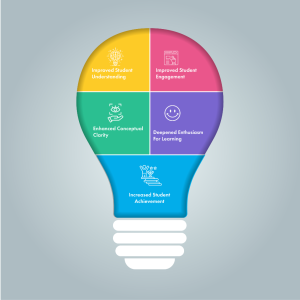
Impact of Teacher Training on Student Learning Outcomes
- Improved Student Understanding: Well-designed teacher training programmes lay a solid foundation for high-quality instruction by equipping teachers with critical pedagogical skills and a variety of teaching strategies that stimulate the learning process. This leads to better knowledge assimilation and real-world application among students.
- Improved Student Engagement and Inclusive Learning: Well-trained teachers employ evidence-based practices, learner-centred approaches, and differentiated instruction to meet diverse student needs and help them stay focused in class.
- Enhanced Conceptual Clarity: The training encourages teachers to gain in-depth subject knowledge, helping them explain concepts to students more clearly and respond accurately to their queries. It facilitates a deeper understanding of the learning material and builds knowledge by drawing connections between different subjects.
- Deepened Enthusiasm for Learning: The ongoing teacher professional development ensures that teachers develop positive attitudes to create a supportive learning environment that encourages students to collaborate and participate enthusiastically in learning activities, seek doubt clarification by asking questions and develop a love for learning.
- Increased Student Achievement: Well-trained educators instil high-order thinking skills among students, leading them to achieve higher academic results and develop a significant interest in their studies.
Thus, improving student outcomes through teacher training is essential for helping learners achieve their full potential and embrace lifelong learning. Our educational policies reflect this commitment through various provisions and recommendations outlined in the National Educational Policy (NEP) and the National Curriculum Framework (NCF)
The Way Forward
NEP 2020 and NCF 2023 have made several recommendations and provisions to improve teacher training in India, aiming to enhance education quality.
Recommendations from NEP 2020
NEP 2020 Recommendations for Teacher Training Improvements
Recommendations from NCF 2023
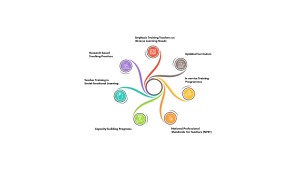
NEF 2023 Recommendations for Teacher Training Improvements
The recommendations outlined in NEP 2020 and NCF 2023 show a way forward to improving teacher training in India, which will aid India in overcoming the learning crisis and achieving learning outcomes aligned with global standards.
Author – Sweta Dholakia, Lead Content Quality Assurance

